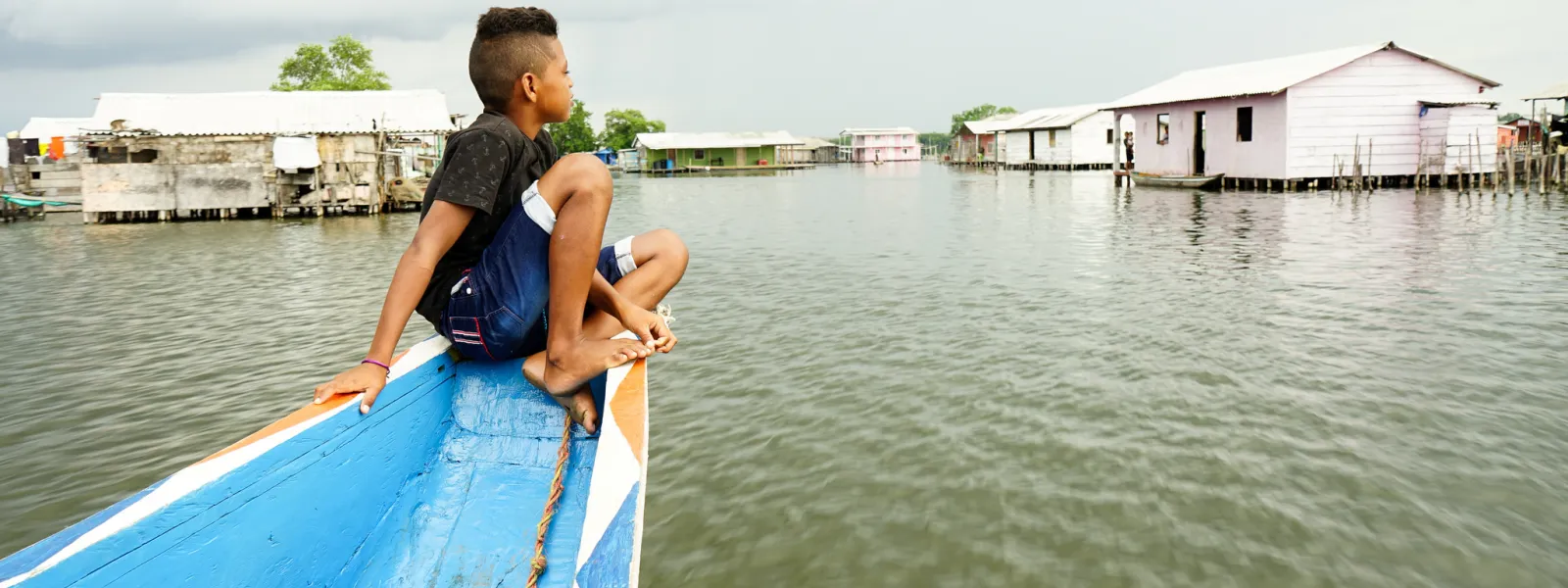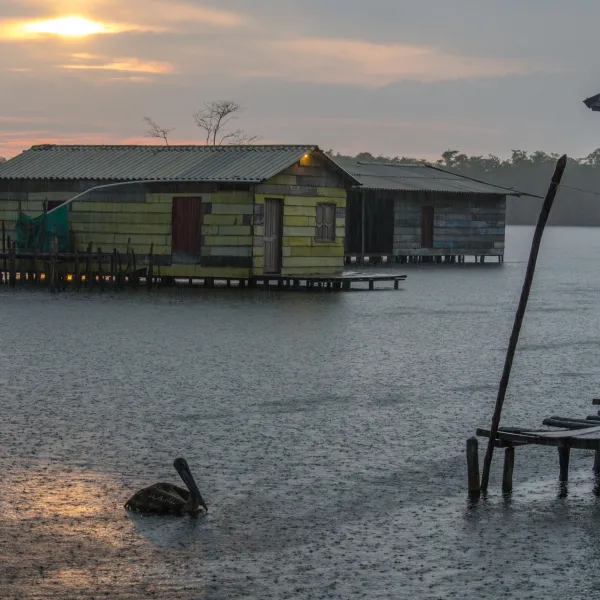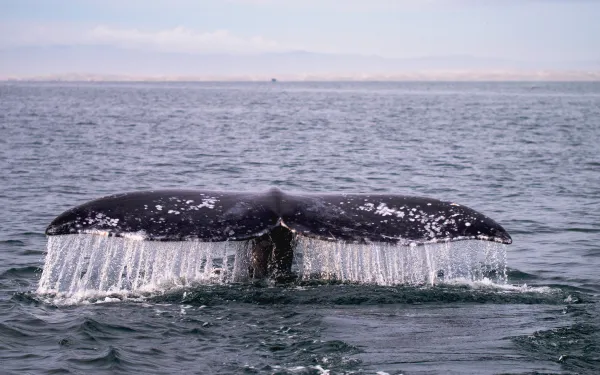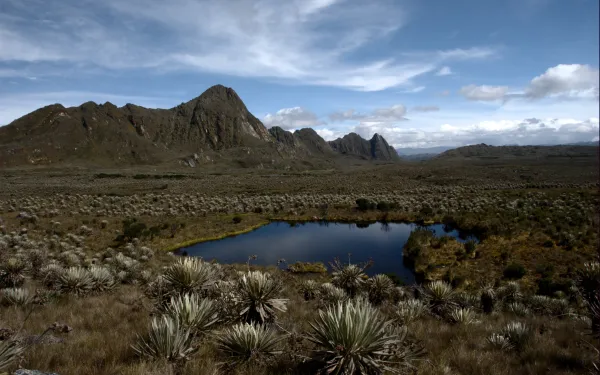
Project
Photo: Anna Laurie Miller / AIDAConserving the Ciénaga Grande de Santa Marta
Ciénaga Grande de Santa Marta, the largest and most productive coastal wetland in Colombia, covers 45,000 hectares. At the confluence of the Magdalena River and the Caribbean Sea, the site boasts an immense variety of flora and fauna, including mammals, birds and fish. Its southern tip is a beautiful sanctuary of mangroves, swamp and amphibious forest.
On the calm waters of the marsh stand the Ciénaga’s famous stilt villages, supported by pillars or simple wooden stakes and inhabited by local fishermen since 1800. In a place accessible only by water, many of the things we take for granted—being served a glass of water, quick access to a doctor—are considered luxuries. Residents depend on the natural world around them. Sadly, in recent years mass fish die-offs caused by the marsh’s degradation have threatened the livelihoods of 2,500 people who call the Ciénaga Grande home.
Illegal activities are destroying this vital ecosystem: intentionally set forest fires, deforestation of large tracks of land for agriculture and livestock, logging and burning of mangroves, and 27 kilometers of illegally built dikes.
This destruction not only devastates the local fishery; it also has global impact. Ciénaga Grande’s mangroves absorb large quantities of carbon dioxide from the atmosphere, aiding in the global fight against climate change.
The importance of the Ciénaga Grande has been recognized both nationally – the Sanctuary of Flora and Fauna Ciénaga Grande de Santa Marta is a national park – and internationally: UNESCO’s Man and the Biosphere program declared the lagoon a biosphere reserve; and the Ciénaga Grande is listed as a Wetland of International Importance under the Ramsar Convention, an intergovernmental treaty for the protection of wetlands.
AIDA and our partners are advocating for the Colombian government to fulfill its national and international obligations to protect the Ciénaga Grande. After all, millions of animals, the local community, and our global climate depend on it.
Partners:

Related projects

10 Things You Should Know About Don Diego
1. Don Diego is a proposed marine mining project in Mexico. Marine mining is a process used to extract metals or minerals from the seabed. The Don Diego proposal calls for dredging seven million tons of phosphate sand from the seabed 19 kilometers off the coast of Baja California Sur.[1] Leftover materials – excess or waste – that are not of interest would be returned to the sea.[2] 2. If created, it would be the first phosphate mine of its type, using this technique, in the region. This makes it impossible to accurately predict the damage that it could do or the measures that could be taken to protect against it.[3] Other countries, such as Namibia and New Zealand, [4] have rejected similar projects due to the severity of their potential impacts. Exploraciones Oceánicas, the company in charge of the project, does not have adequate experience in this area,[5] nor does the Mexican government have the experience to implement and monitor it properly. Even with this uncertainty, the company has not provided a financial guarantee to ensure compliance with the plan for managing, monitoring and supervising Don Diego. 3. It would alter the marine ecosystem. The collection of phosphate sand from the sea, and the deposition of waste, would create sediment that blocks light from entering, in turn affecting marine photosynthesis.[6] Dredging would destroy the health and habitat of benthic species such as oysters and clams, damaging the food chain and the natural equilibrium of the area.[7] The ecosystem could take years to recover. 4. The mine will not necessarily create greater food security in Mexico. Phosphate is used in fertilizer, which helps to produce food. The project’s proponents say a marine mine is needed to make up for reduced global phosphate reserves on land.[8] But beginning an operation of this type, without necessarily understanding the technique and its impacts, could cause more harm than good. In addition, extracting phosphate from Mexico’s waters does not guarantee that the phosphate will then be used to meet the demands of agriculture in Mexico, or in the Americas at all. 5. It would put at risk fisheries and the families that depend upon them. The location of the mining project would overlap with fishing concessions.[9] Ulloa Bay produces nearly 8,450 tons per year of commercial species including abalone, clams, squid, shrimp, snail, dogfish, crab, lobster, oyters, octopus, sharks and rays.[10] Fisheries would decline considerably due to the impacts of dredging the seabed.[11] 6. It would impact an ecologically rich and vulnerable area. Ulloa Bay is a unique marine region characterized by its biodiversity and high productivity. The bay is home to a great number of species of interest both to fisheries and to conservationists. In addition, a portion of the project would spread over 20 percent of the Magdalena Bay Region of Marine Importance,[12] a mangrove ecosystem that provides essential environmental services to coastal communities, including mitigation of climate change. 7. It would further endanger the habitat of the loggerhead turtle. Ulloa Bay is a critical habitat for the endangered loggerhead turtle, so much so that the Mexican government previously named it a refuge for the protection of the species.[13] Studies show that heavy noise, such as the mine would generate, would cause drastic changes in behavior and displace turtles from their habitat.[14] In addition, the Interamerican Convention for the Protection and Conservation of Sea Turtles has recently included mining as one of the listed activities threatening the health and habitat of sea turtles.[15] 8. It would destroy a refuge for the grey whale. Each year, the grey whale travels from Alaska to the warm waters of Baja California Sur to give birth to and raise its young.[16] Whales use sound to identify and locate their pod, and to find and capture their food.[17] Don Diego would generate noise, increase traffic and change the marine ecosystem, forever altering what has been for centuries a refuge for migrating whales.[18] 9. Approval of the project would involve a breach of international obligations on the part of the Mexican government. Mexico has obligations under international law to protect its marine ecosystem and the vulnerable species that depend on its health. The precautionary principle should be applied to this case, as there is no scientific certainty about the magnitude and intensity of the environmental damage that could occur. The Mexican government is required to take measures to avoid such damage, including evaluating a no-project alternative, until it proves that harm can be avoided or minimized. 10. The details of the project are confusing and available public information is incomplete. The duration and specific location of the project remain unclear. For example, the project is proposed to last 50 years, but under the Mining Law it could be extended 50 additional years.[19] [1] Environmental Impact Assessment, Executive Summary of the project “Dragado de arenas fosfáticas negras en el yacimiento de Don Diego”, pp. 4, 5 y 7. Available in Spanish at: http://apps1.semarnat.gob.mx/dgiraDocs/documentos/bcs/resumenes/2015/03BS2015M0008.pdf [2] Todo el proceso es descrito por el promovente, con mayor énfasis en el Capítulo II de la Manifestación de Impacto Ambiental, pp. 23-42. [3] Rofomex was a phosphate project in San Juan de la Costa, close to the city of La Paz, Baja California; the mine produced two million tons of phosphate annually, information available at http://www.dredge.com/dred2-10.html , http://defiendelasierra.org/wp-content/uploads/San-Juan-de-la-Costa.pdf y http://mrdata.usgs.gov/mrds/show-mrds.php?dep_id=10048963; however, the project was located on land and was not in Ulloa Bay, see the extact location here. [4] The first marine phosphate mine was proposed in Namibia in 2013, however the project was not approved and a moratorium was subsequently announced on this activity. See: http://www.scoop.co.nz/stories/WO1307/S00188/marine-phosphate-mining-cannot-be-sustained-by-namibia.htm and http://www.worldfuturecouncil.org/sandpiper-project.html; New Zealand used the precautionary principle to negate permission of an underwater phosphate mine, see: http://www.stuff.co.nz/business/industries/66038589/Chatham-Rock-Phosphate-aghast-mining-consent-refused [5] Website of Exploraciones Océanicas and activity on the NASDAQ stock exchange, which shows the company has never before undertaken a marine phosphate mining project. [6] The phosphate mining industry is considered of the potential sources of nuclear contamination, stemming from elements like Uranium (238U) and Thorium (232Th). The sediments that would be returned to the sea may contain high levels of toxic chemicals, including the presences of these two elements, which would be exposed during the phosphate separation process. Al-Masri, M., Mamish, S. et al. (2002). “The impact of phosphate loading activities on near marine environment: The Syrian Coast.” Journal of Environmental Radioactivity 58 (2002) 35-44. P. 1. [7] Environmental Impact Assessment, Executive Summary of the project “Dragado de arenas fosfáticas negras en el yacimiento de Don Diego,” Chapter VIII, Table VI.3, p. 64, y Chapter V, p. 48. Available in Spanish at: http://apps1.semarnat.gob.mx/dgiraDocs/documentos/bcs/estudios/2015/03BS2015M0008.pdf [8] U.S Geological Survey, Mineral Commodity Summaries, January 2015. Available at: http://minerals.usgs.gov/minerals/pubs/commodity/phosphate_rock/mcs-2015-phosp.pdf [9] Instituto Nacional de la Pesca Oficio RJL/INAPESACA/DGAIPP/978/2014 [10] CONABIO. Estudio sobre la caracterización socioeconómica y pesquera del Área Golfo de Ulloa, BCS (2010). Available in Spanish at: http://goo.gl/7An5o5 [11] Environmental Impact Assessment, Executive Summary of the project: “Dragado de arenas fosfáticas negras en el yacimiento de Don Diego,” Chapter VIII, Table VI.3, p. 64. Available in Spanish at: http://apps1.semarnat.gob.mx/dgiraDocs/documentos/bcs/estudios/2015/03BS2015M0008.pdf [12] Instituto Nacional de la Pesca. Oficio RJL/INAPESCA/DGAIPP/757/2014 [13] The Agreement that establishes the Area of Refuge for the Loggerhead Turtle (Caretta Caretta) in Ulloa Bay in Baja California Sur was before the Federal Regulatory Improvement Commission to obtain an approving opinion, December 9, 2014. 2014. Available in Spanish at: http://www.cofemermir.gob.mx/mir/crLecAnte.asp?submitid=33808 [14] Convention on Biological Diversity. “Sea turtle hearing and sensitivity to acoustic impacts.” Available at: https://www.cbd.int/doc/meetings/mar/mcbem-2014-01/other/mcbem-2014-01-submission-boem-03-en.pdf, pgs. 3 and 4. [15] Interamerican Convention on the Protection and Conservation of Sea Turtles, Seventh Conference of Parties, June 24-26, 2015, Mexico City. Resolution CIT-COP7-2015-R3. Available at: http://www.iacseaturtle.org/docs/resolucionesCOP7CIT/CIT-COP7-2015-R3_Cabezona_ Resolucion_ESP_7.15.15_ADOPTADA.pdf [16] Guerrero Ruiz, M., Urbán Ramírez, J. y Rojas Bracho, L. 2006. Las ballenas del golfo de California. Secretaría de Medio Ambiente y Recursos Naturales (SEMARNAT). Instituto Nacional de Ecología (INE). 537 pp. [17] Baker C. S. y C. M. Herman. 1984. Aggressive behavior between Humpback whales (Megaptera novaeangliae) wintering in Hawaiian waters. Can. J. Zool. 62(10): 1,922-1,937.; Croll, D. A., C. W. Clark, A. Acevedo, B. R. Tershy, S. Flores, J. Gedamke y J. Urbán. 2002. Only male fin whales sing loud songs. Nature 417: 809. [18] Annex 13 is a three page document that does not support the conclusions of the company in the environmental impact assessment. [19] Environmental Impact Assessment, Executive Summary of the project “Dragado de arenas fosfáticas negras en el yacimiento de Don Diego,” Chapter II, p. 4. Available in Spanish at: http://apps1.semarnat.gob.mx/dgiraDocs/documentos/bcs/estudios/2015/03BS2015M0008.pdf
Read more
AIDA statement on the signing of the Paris Accord
AIDA celebrates the first step toward the construction of a new planet. New York, USA. Today, on Earth Day, in the headquarters of the United Nations, the Paris Agreement opens for signatures. The signing of the accord by Member States of the UN Framework Convention on Climate Change is necessary to enable the treaty to quickly enter into force. The agreement lays out actions the world must implement to tackle climate change, the greatest threat humanity faces. The following is a statement by AIDA co-directors Astrid Puentes Riaño and Anna Cederstav: “Today we celebrate the historic signing of the Paris Agreement, a vital step and a new beginning in humanity’s efforts to tackle climate change. This accord, and its immediate signing and ratification by all nations, brings hope to our planet and for future generations. We recognize that the Agreement is not perfect, but we understand the complexity of nearly 200 countries reaching consensus on sensitive issues. The agreement is therefore a critical first step on the path toward ambitious and effective results. One of the Agreement’s noteworthy advances is the recognition that all climate actions must take into account and respect human rights and the rights of indigenous peoples, while also ensuring gender and intergenerational equality and a just transition of the workforce. The Agreement also recognizes the large gap that exists between the commitments made by States and the urgent measures needed to avoid catastrophic consequences, including the need for increased climate finance. We therefore hope that the celebration, speeches and official photographs will translate into prompt and effective action that goes beyond the agreements made in Paris last December. The Paris Agreement reflects a paradigm shift that is both necessary and possible. For Latin America and the Caribbean, highly affected and vulnerable regions, the Agreement presents a unique opportunity to achieve low-carbon development that prioritizes the protection of communities, people and ecosystems. AIDA has participated in the climate negotiations for many years as a Latin American voice. It makes us proud that our efforts, alongside those of the countless people and organizations with whom we’ve worked, have come to bear fruit. The signing of the Agreement today commits us to continuing our work to ensure compliance. Responding to climate change is everybody’s job, considering differentiated capabilities and responsibilities. States have an obligation to sign, ratify and immediately implement the Paris Agreement. International organizations, financial institutions and corporations must acknowledge their responsibility. And we, as individuals, must all examine our personal actions and how we can contribute to reducing climate change. Each and every contribution is essential to the adoption of real solutions that lead the way to a more just and sustainable world. The signing of the Paris Agreement today evidences important political will that must be translated, without delay, into concrete results. The most vulnerable and most severely affected countries cannot wait.”
Read more
New law banning mining in Colombia’s páramos could draw its first lawsuit
The new law that bans mining in Colombia’s páramos took years to materialize, and was the product of multiple activist campaigns, lawsuits, and pressure from civil society to preserve one of the world’s most sensitive ecosystems. Last month, Colombia’s Constitutional Court approved a law that has no precent. It bans mining and oil exploitation –effectively blocking 473 already-existing concessions– in the country’s páramos. The law is expected to impact more than 300 mining operations in 25 moorlands, according to data from the National Authority of Environmental Licenses (ANLA). One of those companies is the Canadian transnational, Eco Oro. Its Angostura mine is located within the Santurbán moorland, in the Norte de Santander and Santander departments, within an area larger than 142,000 hectares. Santurbán includes five regional parks and a variety of species in danger of extinction, such as the condor (Vultur gryphus), the chirriador (Cisttothorus apollinari), the moorland duck (Anas flavirostris) and the curí (Cavia porcellus). On its website, the company has announced that it is “developing a multi-million ounce gold-silver deposit in Colombia.” Eco Oro has already completed more than 350,000 meters of drilling and 3,000 meters of underground development, thanks to an investment by the International Financing Corporation of the World Bank. Juan Orduz, president of Eco Oro’s board of directors, said back in 2014 –before the law was approved– that the company “has invested more than 240 million dollars in the region.”“It’s no secret that we’ve had many challenges and that we will keep having them. There’s always a new source of conflict, and even then, we’re going to keep coming up with strategies to keep working in this area,” said Orduz back then, when the demarcations for mining in Colombia’s páramos were an issue of conflict. In a recent press release, Eco Oro announced that it has the option of bringing the dispute to international arbitration and seeking “monetary compensation for the damages suffered” due to the new anti-mining law. “Since the Angostura project got underway, it has been clear that páramos are constitutionally and legally protected and that this project could affect Santurbán, such that it might not be authorized,” said Carlos Lozano Acosta, an attorney with the Interamerican Association for Environmental Defense (AIDA). “States should not be sanctioned for protecting their water sources, given that they are doing so in accordance with national and international obligations.” According to data from the Institute of Biological Research Alexander Von Humboldt, half of the world’s páramos are in Colombia and are the source of 70% of the fresh water in the country, besides being an ecosystem essential for mitigating climate change. Their importance is especially acute right now, since Colombia is facing the El Niño climate phenomenon and going through one of the worst droughts in its history. Eco Oro’s critics explain that five years ago, Colombia’s Environment Ministry had denied the Angostura mine its environmental license. And now, the decision of the Constitutional Court reaffirms that decision, “finding that the right to water and the protection of the páramos (moorlands) takes precedent over the economic interests of companies trying to develop mining projects in these ecosystems.” That’s according to Miguel Ramos, from the Water Defense Committee and the Páramo of Santurbán (El Comité por la Defensa del Agua y el Páramo de Santurbán). The Committee has presented a complaint about the Angostura mining project to The World Bank, and hopes to receive a response in the next few months.
Read more